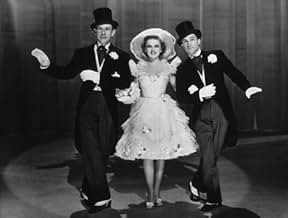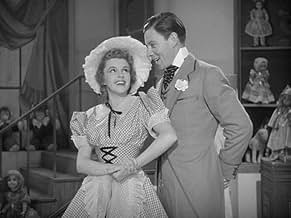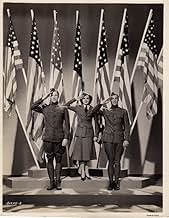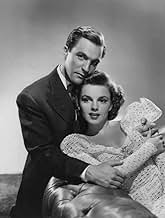CALIFICACIÓN DE IMDb
7.0/10
4 k
TU CALIFICACIÓN
Agrega una trama en tu idiomaTwo vaudeville performers fall in love, but find their relationship tested by the arrival of WWI.Two vaudeville performers fall in love, but find their relationship tested by the arrival of WWI.Two vaudeville performers fall in love, but find their relationship tested by the arrival of WWI.
- Dirección
- Guionistas
- Elenco
- Nominado a 1 premio Óscar
- 4 premios ganados y 1 nominación en total
Mártha Eggerth
- Eve Minard
- (as Marta Eggerth)
Stephen McNally
- Mr. Waring
- (as Horace McNally)
Ernie Alexander
- Theater Workman with Big Die
- (sin créditos)
Hooper Atchley
- Assistant Stage Manager
- (sin créditos)
Walter Baldwin
- Bill
- (sin créditos)
Gurney Bell
- Member - Sportsmen Quartet
- (sin créditos)
John Breen
- Soldier
- (sin créditos)
Ken Darby
- Member - The King's Men
- (sin créditos)
George Davis
- France Taxi Driver
- (sin créditos)
Bill Days
- Member - Sportsmen Quartet
- (sin créditos)
John Dilson
- Lou
- (sin créditos)
Jon Dodson
- Member - The King's Men
- (sin créditos)
Lester Dorr
- Stage Manager
- (sin créditos)
Ruth Dwyer
- Nurse
- (sin créditos)
Opiniones destacadas
Gene Kelly makes his smashing screen debut in For me and my gal. That alone should make it a must see. This movie was a delight for numerous reasons. First, I like the fact that this movie was a musical/drama. So, we were able to get a full dose of the manifold talents of Gene Kelly and Judy Garland. Second, the chemistry that Judy and Gene had in this movie was exceptional. The scene in which they are singing the title song is riveting. George Murphy was solid in his role as the amiable friend and colleague, who was a good example of selflessness.
This movie is not as renowned as other Garland classics such as the wizard of Oz and Meet me in St. Louis. However, I think this was her most endearing role. She was beautiful, sweet and vivacious in this movie. I can watch this movie repeatedly, and so should everyone else.
This movie is not as renowned as other Garland classics such as the wizard of Oz and Meet me in St. Louis. However, I think this was her most endearing role. She was beautiful, sweet and vivacious in this movie. I can watch this movie repeatedly, and so should everyone else.
This was Gene Kelly's first foray into film, thanks to Judy Garland. Judy herself is only three years beyond "The Wizard of Oz" and at the top of her talents. Their pairing alone makes this a film worth seeing. Now, when we hear their voices harmonizing---especially in the title song---it feels iconic.
This is really two films joined together. The first part is the story of vaudeville, and an opening dedication page says that. As their characters, Jo and Harry, meet, team up and struggle to make the big time, the viewer is regaled by song and dance, specialty acts and vaudevillian humor. George Murphy plays the part of Jimmy Metcalf, who winds in and out of their lives.
The action takes place in 1916, just before the U. S. enters WWI. When the RMS Lusitania is sunk, the tenor and style of the film changes. Audiences in 1942 could identify with the patriotic fervor depicted, and it stimulated their nationalistic impulses to buy war bonds, participate in various drives, and forgo many luxuries. The second section of the film, much of which is a montage, is designed to stir up a unified American response to the Axis powers. So, there is no discussion of isolationism or Washington's warnings against foreign entanglements, though they might have been authentic.
In that second section, Jo and Harry's story is secondary to the bigger national story, but it is still there. Unfortunately, the dramatic transition between the two parts is thematically disruptive. It's a criticism that filmgoers of the forties would not have lodged. The review by the New York Times, in its roundabout way, does find fault with the script and its tale of two stories.
Martha Eggerth, the soaring soprano, plays a small role that is notable because she seldom appeared in films west of the Atlantic.
This is a film worth seeing, especially as an example of wartime cinema.
This is really two films joined together. The first part is the story of vaudeville, and an opening dedication page says that. As their characters, Jo and Harry, meet, team up and struggle to make the big time, the viewer is regaled by song and dance, specialty acts and vaudevillian humor. George Murphy plays the part of Jimmy Metcalf, who winds in and out of their lives.
The action takes place in 1916, just before the U. S. enters WWI. When the RMS Lusitania is sunk, the tenor and style of the film changes. Audiences in 1942 could identify with the patriotic fervor depicted, and it stimulated their nationalistic impulses to buy war bonds, participate in various drives, and forgo many luxuries. The second section of the film, much of which is a montage, is designed to stir up a unified American response to the Axis powers. So, there is no discussion of isolationism or Washington's warnings against foreign entanglements, though they might have been authentic.
In that second section, Jo and Harry's story is secondary to the bigger national story, but it is still there. Unfortunately, the dramatic transition between the two parts is thematically disruptive. It's a criticism that filmgoers of the forties would not have lodged. The review by the New York Times, in its roundabout way, does find fault with the script and its tale of two stories.
Martha Eggerth, the soaring soprano, plays a small role that is notable because she seldom appeared in films west of the Atlantic.
This is a film worth seeing, especially as an example of wartime cinema.
I thought Judy Garland gave an Oscar worthy performance in this movie. As for Gene Kelly, it was hard to believe that this was his movie debut, his acting made it seem as if he'd been around Hollywood for years. And oh, that musical score, remeniscent of some film scores by Irving Berlin. Not just your ordinary musical, this one has a fine story that fits in with the time of World War One. The title song as done by Garland & Kelly is a classical show-stopper. For sentimentalists, like my wife and I, there are a few scenes that tug at the heart strings, and provide for some misty eyes.
'For Me and My Gal' had so much going for it on paper, with the involvement of immensely talented people like Judy Garland, Gene Kelly and Busby Berkeley. It has its flaws, but when it's good it's fabulous and showcases the two stars brilliantly.
The story and script are admittedly slight and heavy in the clichés, complete with an ending that feels tacked on (and apparently it was, hardly surprising). The supporting cast's performances also don't compare to those of Kelly and Garland. Well George Murphy is good, he is very likable and charming, the problem is that he is underused and deserved more considering his talent. Ben Blue is unfunny and annoying however, and Marta Eggerth seemed out of place, am a fan of the operatic style of singing but there are far more beautiful voices than Eggerth's rather shrill and metallic sound and the singing doesn't really fit the style of the songs.
However, it is very difficult to be too hard on 'For Me and My Gal' because it fills me with so much joy and really does tug at the heart. The best thing about the film is Garland, who is absolutely sensational, with remarkably graceful dancing and as ever her voice is one you can listen to for hours and not get enough of. Her role here is also one of her most relatable and radiantly likable ones. Kelly may have had more endearing roles in his career, but he really shines in charm and technical skill in his debut where his material plays marvellously to his strengths. The two of them are simply magical together, and one is entranced every time they're on screen together or individually.
It is also a visually beautiful film. Technicolor it ain't, but it is not a film that cries out for it. The lavishness and elegant sumptuousness is still there and it is beautifully filmed. The songs are truly lovely, with the title song and "When You Wore a Tulip" standing out, and advantaged even further by top-notch direction and choreography by Berkeley (throughout, but especially in those two numbers), it may lack the kaleidoscopic style of his earlier films but never looks overblown or static, basically what cinema is all about.
While flawed, the story is still very charming, is lots of fun and there are also some genuinely touching parts that tug at the heart-strings. The pacing never feels dull, even with the slightness, which faces the danger of over-stretching and padding, and over-familiarity.
All in all, not a favourite but for fans of Kelly, Berkeley and especially Garland it is a must regardless of its issues. 8/10 Bethany Cox
The story and script are admittedly slight and heavy in the clichés, complete with an ending that feels tacked on (and apparently it was, hardly surprising). The supporting cast's performances also don't compare to those of Kelly and Garland. Well George Murphy is good, he is very likable and charming, the problem is that he is underused and deserved more considering his talent. Ben Blue is unfunny and annoying however, and Marta Eggerth seemed out of place, am a fan of the operatic style of singing but there are far more beautiful voices than Eggerth's rather shrill and metallic sound and the singing doesn't really fit the style of the songs.
However, it is very difficult to be too hard on 'For Me and My Gal' because it fills me with so much joy and really does tug at the heart. The best thing about the film is Garland, who is absolutely sensational, with remarkably graceful dancing and as ever her voice is one you can listen to for hours and not get enough of. Her role here is also one of her most relatable and radiantly likable ones. Kelly may have had more endearing roles in his career, but he really shines in charm and technical skill in his debut where his material plays marvellously to his strengths. The two of them are simply magical together, and one is entranced every time they're on screen together or individually.
It is also a visually beautiful film. Technicolor it ain't, but it is not a film that cries out for it. The lavishness and elegant sumptuousness is still there and it is beautifully filmed. The songs are truly lovely, with the title song and "When You Wore a Tulip" standing out, and advantaged even further by top-notch direction and choreography by Berkeley (throughout, but especially in those two numbers), it may lack the kaleidoscopic style of his earlier films but never looks overblown or static, basically what cinema is all about.
While flawed, the story is still very charming, is lots of fun and there are also some genuinely touching parts that tug at the heart-strings. The pacing never feels dull, even with the slightness, which faces the danger of over-stretching and padding, and over-familiarity.
All in all, not a favourite but for fans of Kelly, Berkeley and especially Garland it is a must regardless of its issues. 8/10 Bethany Cox
The classic plot of girl refuses guy only to fall in love with him later is at work again. When the girl happens to be Judy Garland, one of the top box office draws and the MGM triple threat of extraordinarily talented singer, actress and dancer, it kind of changes the whole perspective. In the MGM heavens there are no leading men who can match her on screen stature.
To solve that problem, she gets two leading men. Before World War 1, the vaudeville girl has to choose between two partners. George Murphy and Gene Kelly. Fresh from Broadway success with "Pal Joey", Mr Kelly makes his movie debut in "For Me and My Gal" and it is nothing short of memorable. It was time the world saw that Hollywood dancers wore something other than white tails and top hat, like Mr Astaire.
The screenplay is slight. It hardly matters, because World War 1 is enough of a threat to forward the story anyway. All elements of drama and tear jerking romance are there. For a routine musical at MGM, we expect our happy 40s story, all complete with happy ending, plus the usual congenial mix of complications along the way. And with direction from Busby Berkley, great 1915s songs and two of the greatest musical stars in the mix, we certainly get our happy ending.
Today it stands out because of its musical quality and excellent conception of production. They certainly don't make 'em like this anymore.
Rating: 8/10
To solve that problem, she gets two leading men. Before World War 1, the vaudeville girl has to choose between two partners. George Murphy and Gene Kelly. Fresh from Broadway success with "Pal Joey", Mr Kelly makes his movie debut in "For Me and My Gal" and it is nothing short of memorable. It was time the world saw that Hollywood dancers wore something other than white tails and top hat, like Mr Astaire.
The screenplay is slight. It hardly matters, because World War 1 is enough of a threat to forward the story anyway. All elements of drama and tear jerking romance are there. For a routine musical at MGM, we expect our happy 40s story, all complete with happy ending, plus the usual congenial mix of complications along the way. And with direction from Busby Berkley, great 1915s songs and two of the greatest musical stars in the mix, we certainly get our happy ending.
Today it stands out because of its musical quality and excellent conception of production. They certainly don't make 'em like this anymore.
Rating: 8/10
¿Sabías que…?
- TriviaGene Kelly's film debut. It is known that Judy Garland got him the job after seeing him in the Broadway musical "Pal Joey". Kelly made films in a variety of genres over the next few years but became best known for his energetic dancing style in MGM hits such as Leven anclas (1945), Un día en Nueva York (1949), and Un Americano en París (1951). Kelly, who was a choreographer and director as well as a dancer and singer, received a special Academy Award in 1951 in recognition of his outstanding achievement as an actor, dancer, singer and director. He also received a Life Achievement Award from the American Film Institute in 1985. The song "For Me and My Gal" became one of Kelly's signature songs.
- ErroresJo's YWCA uniform (like much of her clothing in the latter half of the film) is characteristic of World War II, when the film was released, and not World War I, in which it is set. Her uniform's shoulders are too broad and the skirt too short, and she is wearing sheer stockings and pumps instead of opaque stockings and high boots or oxfords.
- Citas
Harry Palmer: Why didn't you tell me I was in love with you?
- Créditos curiososA picture of an infantry soldier in New York harbor and the text "America needs your money. Buy war bonds and stamps at this theatre."
- Versiones alternativasThere is a 1993 colorized version of the film that aired on TNT
- ConexionesEdited into American Masters: Gene Kelly: Anatomy of a Dancer (2002)
- Bandas sonorasFor Me and My Gal
(1917) (uncredited)
Music by George W. Meyer
Lyrics by Edgar Leslie and E. Ray Goetz
Played during the opening credits and often as background music
Played on piano (with background orchestra) by Judy Garland (uncredited) and sung and danced by her and Gene Kelly (uncredited)in a coffee shop
Reprised by Judy Garland (uncredited), Gene Kelly (uncredited) and chorus at the end
Selecciones populares
Inicia sesión para calificar y agrega a la lista de videos para obtener recomendaciones personalizadas
- How long is For Me and My Gal?Con tecnología de Alexa
Detalles
- Fecha de lanzamiento
- País de origen
- Idiomas
- También se conoce como
- For Me and My Gal
- Locaciones de filmación
- Productora
- Ver más créditos de la compañía en IMDbPro
Taquilla
- Presupuesto
- USD 802,000 (estimado)
- Tiempo de ejecución1 hora 44 minutos
- Color
- Relación de aspecto
- 1.37 : 1
Contribuir a esta página
Sugiere una edición o agrega el contenido que falta

Principales brechas de datos
By what name was Mi chica y yo (1942) officially released in India in English?
Responda
































